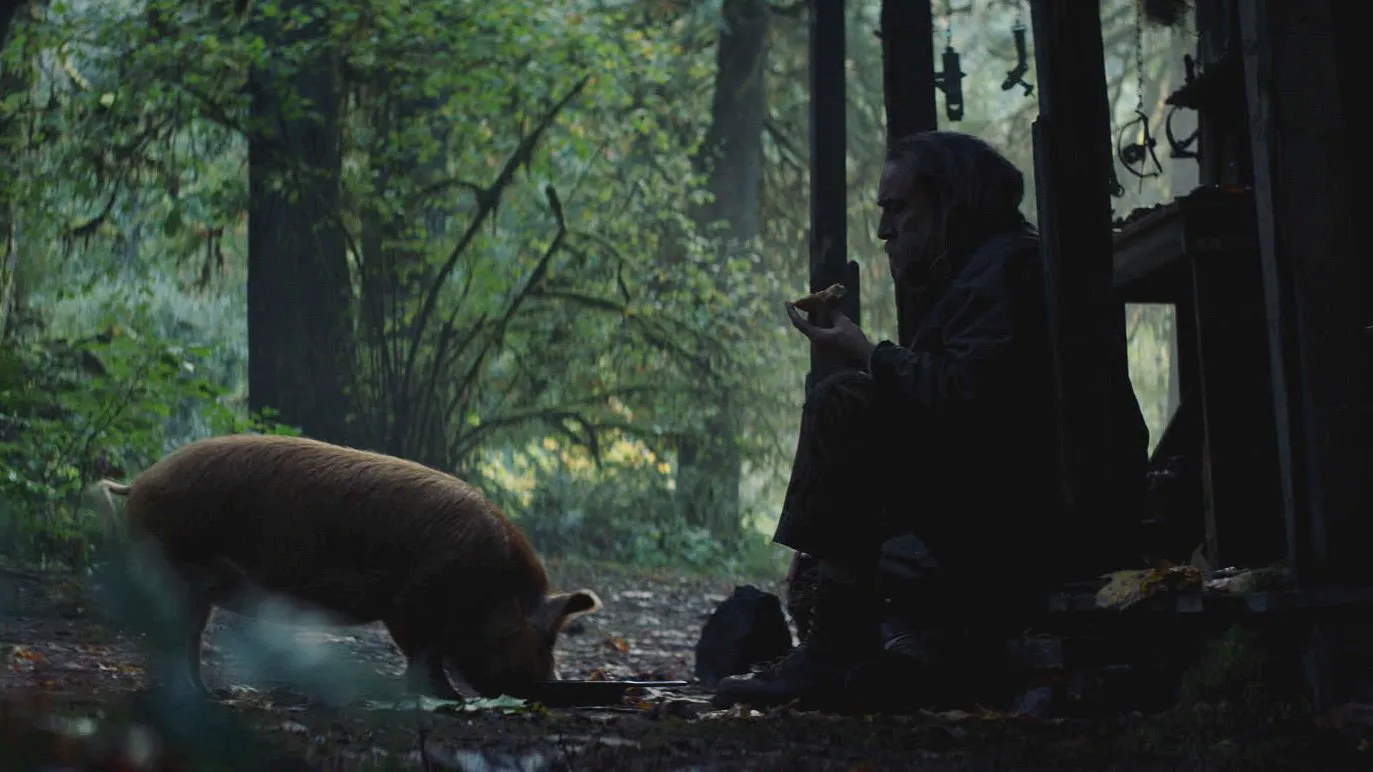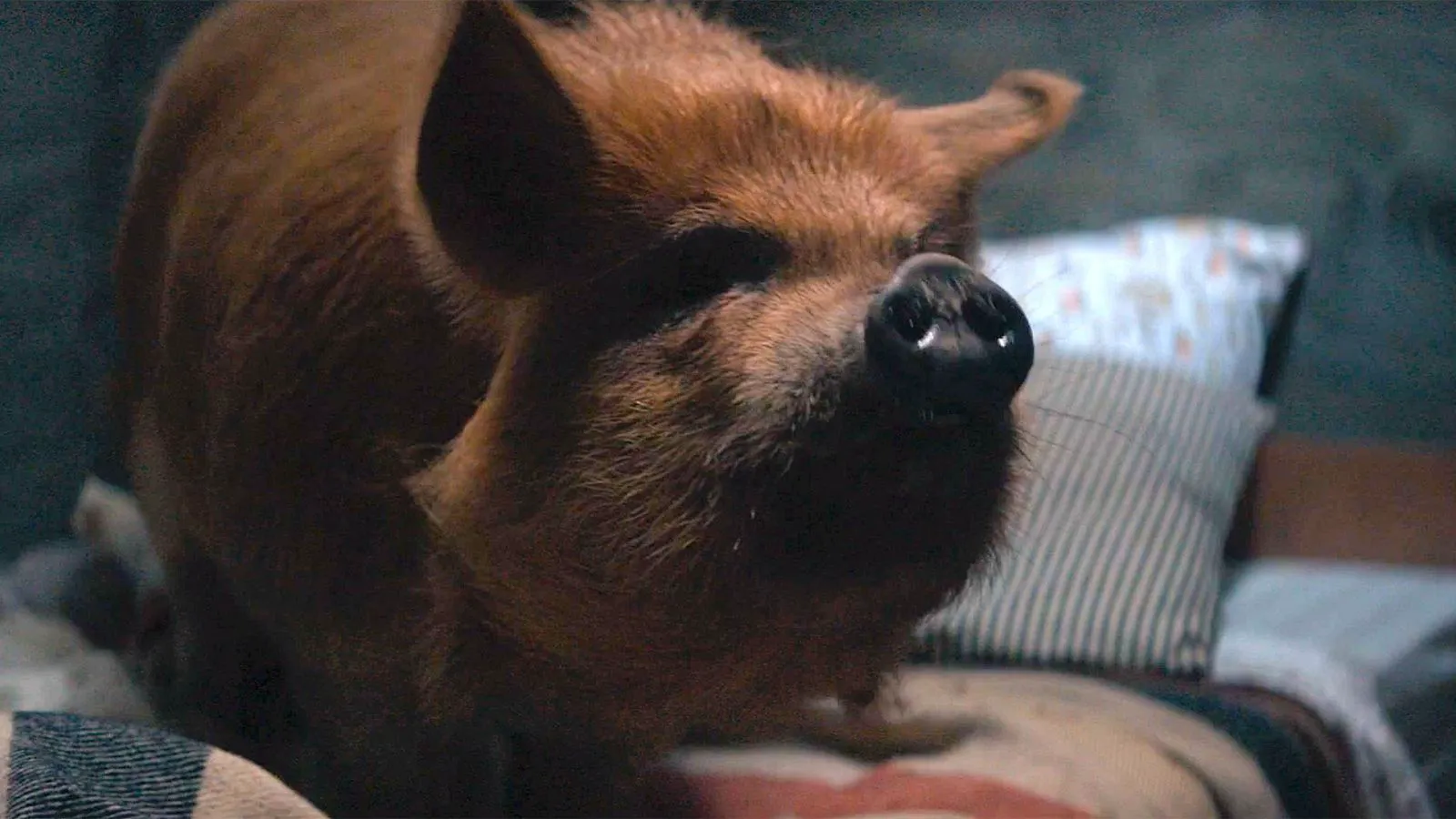A Truffle, a Pig, and a Revelation: Unpacking the Enigmatic “Pig”
Rob (played by Nicolas Cage, as if there were any doubt), a bearded and disheveled recluse, has lived a solitary life for fifteen years in a dilapidated forest cabin with his loyal truffle pig. Their days are spent foraging for mushrooms and huddling by the warm stove. Occasionally, they’re visited by Amir (Alex Wolff), a pretentious young man who arrives every Thursday for a fresh batch of truffles. Amir begrudgingly pets the pig, who is drawn to him and his Camaro, attempts to engage the taciturn Rob in conversation, collects the coveted box of delicacies, and departs for another week. This tranquil existence is shattered one night when a pair of unknown assailants break into Rob’s home, beat him, and steal his pig. Upon regaining consciousness, the old man immediately sets out to find her, only to realize that Amir is the only acquaintance he has left. Together, they journey to the city where the thieves are likely hiding, but the theft proves to be more complex than it initially appears, unveiling a poignant secret about both Rob and his seemingly vapid companion.

Nicolas Cage as Rob in “Pig”
Beyond Cagesploitation: A Quiet Drama in Disguise
In the grindhouse theaters of 20th-century America, “exploitation” films thrived, relentlessly exploiting popular themes. These ranged from general topics like sex and violence to more specific ones like biker gangs, Bruce Lee imitations, and post-apocalyptic scenarios inspired by “Mad Max.” While these theaters have closed, the format has migrated to VOD, with films about killer donuts or mutant rats now populating streaming services and torrent trackers. It’s somewhat surprising that Nicolas Cage, an actor who once worked with Scorsese, the Coen brothers, and Lynch, has become a part of this culture, now battling poorly rendered CGI tigers and animatronics. Some Western critics have even coined the term “Cagesploitation” to describe films that deliver exactly what their trailers promise: a crazy Cage, lots of blood, and absurdity – in short, a bad movie. This type of film can be a guilty pleasure. And among these films, there are some outstanding ones, such as “Mandy” by Cosmatos, or “Color Out of Space” – an old-fashioned b-movie that feels like it was filmed in the wild 80s.
“Pig” is valuable precisely because it isn’t Cagesploitation. Of course, from a production standpoint, the famous actor’s face on the poster guarantees additional audience interest. And the synopsis is, shall we say, misleading: a crazy, bearded woodsman who has nothing to lose sets out to avenge his stolen animal. This immediately creates the false impression that “Pig” is a classic revenge thriller in the vein of “Mandy,” only with a beloved pig instead of a wife murdered by cultists. It would seem that all the elements of Cagesploitation are present: a wild Cage, his silly improvisations, a crazy plot twist, bad graphics, and a headache after 30 minutes of the film.

A scene from “Pig”
However, this game ends with the first point. “Pig,” despite all its trappings of a mediocre thriller, turns out to be a quiet, sometimes even overly restrained, indie drama. Where other films would pile on bizarre details, this one prefers to remain silent. Where any revenge movie would descend into a bloody vendetta, this film becomes a humanist anthem of love and forgiveness. And all this, strangely enough, is still peculiar, sometimes even absurd – like almost any film with Cage made in the last decade. “Pig” is touching but not saccharine; extreme but not vulgar. It is simply genuine and elusively alive – which is why it is so difficult to describe it without sounding like a collection of random words.
Portland as a Landscape of Memory and Loss
First and foremost, this is a film about humility. With oneself, with the people around, but more importantly, with the big city. “Pig” resembles a midnight elegy of deserted streets, seedy underground places like the basement with fight clubs, and elite restaurants. The geography of Portland is chaotic, pieced together from Rob’s visits to places he once knew. “Pig” is one big memory: of a deceased lover, of friends, of enemies, of homes and people who have become strangers. The voluntary exile of old Robin, whose name still means something in these parts, turns into a forced return. But the scariest thing about such a comeback is not the confrontation with the ghosts of the past – it is scarier to see your true self reflected in the giant windows and mirrors here. “We take local ingredients and make the familiar feel unfamiliar,” is how chef Finway, whom the two pig seekers will visit, describes the concept of his establishment. Although this recipe is more suited not to the pretentious Eurydice establishment, but to Michael Sarnoski’s debut itself – he makes you look at the concrete jungle through the eyes of an outsider, not so much to recognize the places shown, but to stumble upon phantom memories of them.

Nicolas Cage as Rob in “Pig”
But you can’t stay here for long: the big city will devour a person, destroy them from within. Grief will turn into an unending hatred of oneself, joy into pride, loneliness into madness. Both Amir, seemingly foolish and devoid of all empathy, but in reality a sensitive young man with a lot of complexes, and the hermit Rob are simply parts of the local landscape. Chef Finway, whom Cage’s character fired many years ago for perpetually overcooked pasta, dreamed of opening an English pub, but became the chef of a pretentious restaurant. Amir’s mother could not stand living with her businessman husband and committed suicide. The city holds many secrets, but “Pig,” alas or fortunately, will only tell about those of them that are interconnected.
A Dreamlike State: Blurring the Lines of Genre
Whether it’s Cage’s relentless energy or Sarnoski’s own desire to take “Pig” beyond the hazy memory of the past, dreary Portland is quickly falling into a playful dream. For a revenge film, this movie is too tender; for a poignant drama about loss, it’s too strange. First, Rob launches into a monologue about an earthquake that will bury the damn city under water and return people to where they came from, and then he ends it all with an optional comment about what kind of bread is best for making toast (stale, you’re welcome). Chef Finway bursts into tears right in the hall, realizing how quickly he turned from an inept but sincere boy into a pretentious chef. A sweet old woman in charge of truffle hunting in the area, upon learning of the pig’s theft, curses, it seems, with all the swear words from her vocabulary and vows to break the fingers of anyone who decides to do something wrong in her absence. Rob’s character, and with him others, have long been a little crazy – and in this collective madness there is also something simple, understandable, and ultimately familiar to everyone who has ever experienced loss.
Culinary Metaphors and the Search for Authenticity
In this sense, “Pig” resembles “Ratatouille”: through the prism of culinary metaphors and spectacular (and even frighteningly appetizing – don’t watch this movie on an empty stomach) shots of the most unimaginable dishes, it also tells about a simple human trauma. Art is like a litmus test for all problems and complexes, beauty behind which lies loneliness and detachment. You can’t run away from yourself and from others, working in a restaurant with pompous aesthetes will never be sweeter and more pleasant than your own English pub with stained tables and Scotch egg as a signature dish, a pig will never replace a beloved wife, and imitating a business parent will not bring you closer to an indifferent father. The truth is in naturalness and acceptance, and if some of the film’s characters find this acceptance difficult, then “Pig” itself has no problems with simplicity and sincerity.
Cage’s Confession: Embracing the Oddity
Even more interestingly, “Pig” reads as a confession from the mad Cage. He is, in a sense, also a hermit – a local legend who disappeared from the radar for many years, and now occasionally returns to either big (“Spider-Man: Into the Spider-Verse”) or small, but recognized by audiences and critics, films (“Mandy”). Whether this is an escape from something, a challenge, or a pursuit of easy money is unclear, but it seems that “Pig” proves an already simple but important idea: there is more naturalness in Cage’s unnaturalness (his screams, bulging eyes, which have become memes) than in anyone else’s. Sarnoski’s film is also about how important it is to remain a weirdo and a bungler – in a world full of serious businessmen and thoughtful artists, they are desperately lacking.